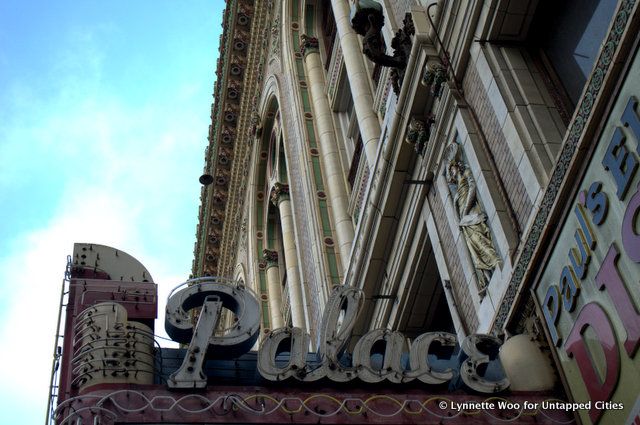Artist-Led Tour of "ENCORE" Photo Exhibit w/ Mark S. Kornbluth
Join photographer Mark S. Kornbluth for a visual exploration of NYC's Broadway theaters at Cavalier Galleries!


Every year, the Los Angeles Conservancy hosts Last Remaining Seats, a series of screenings held in several of the historic Los Angeles movie palaces. Last year, we checked out the ornate Los Angeles Theater. This year, we attended the screening of La Bamba inside the Palace Theater. The Palace was built in 1911, designed by architect G. Albert Lansburgh, a graduate of Paris’s prestigious Ecole des Beaux-Arts famous for his landmark buildings in San Francisco and extravagant theaters (he designed over 50 nationwide). In Los Angeles, he was responsible not only for the Palace, but the Orpheum, Wiltern Theatre, El Capitan Theatre and Shrine Auditorium as well.
Before being renamed in 1926, the Palace Theatre was the third home of the Orpheum and the Orpheum Vaudeville Circuit, a vaudeville circuit on the West Coast, frequented by the biggest comedians, singers, dancers, acrobats, ventriloquists, and performers of the time, including heavy hitters like Will Rogers and Bob Hope.
In the basement, empty green rooms still wait expectantly beneath the stage, and visitors can wander through the debarred animal cage where performing animals used to wait with their nervous trainers for their turn on stage. The basement of the Palace also leads out to the men’s room, which sits directly beneath the street, and former smoking lounge.
We took the stairs up to the second story, checking out the lighted mirrors of the women’s lounge and surveying incoming guests through its wide windows. Apparently, women used this window to look for their male escorts, without whom they could not enter alone–before moving into the auditorium.
Recent renovations in 2011 have restored the deep plum walls and ornate decorations of the Palace to their former glory. The floral embellishments over the second story entrances were discovered during renovations. Workers pulled back layers of curtain and plaster covering the doorway and found the original moldings. Using these remains and old photographs, designers pieced together and restored the moldings. They also re-created the original design of the formerly hand-stenciled walls, bringing back the Palace’s former sense of luxury. The bronze vine-wrapped columns complete and frame the elegant details requisite in a European opera house of the 17th century.
With no original stereo sound system, the theatre was designed so that no seat would be further than 80 feet from the stage. The most expensive seats were front and center in the first two rows of the second level balcony. The upper level third balcony seats, once half-priced for those who couldn’t afford such luxuries, have since been removed and left completely vacant–accessible only, and at times dangerously, by fire escape
Eventually, the former vaudeville stage made the transition to silent films, before the theatre turned into a full-fledged movie palace with a brand new sound system. The remnants of the orchestra pit have also disappeared, making way for additional, and considerably more comfortable, velvety, crimson cushioned seats in lieu of the old hard metal chairs.
Settling into our seats, we leaned back and craned our necks to see the painted arched domes above, and to our right and left, wall-sized murals of pastoral scenes painted by Anthony Hiemsburgen. These were covered by red velvet until just a few years ago. These murals had replaced what were formerly box seats no longer needed in the age of film. The screen itself sat astern on the stage, hidden by a gold-tasseled set of rusty red curtains crested by a proscenium garnished with gold floral detailing and the placid face of one of the muses of Vaudeville.
After the movie, we headed back out through the foyer and paused on the street outside the Palace Theatre, overlooked by the oldest existing architectural structure in Los Angeles: four life-sized terra cotta figures designed by Domingo Mora depicting the muses of Vaudeville standing symbolically atop the façade panels.
Comedy, Dance, Song and Music–these Vaudevillian muses–form an important part of our culture and figure in our memories. The Palace’s history and ethos is part of that tradition of American pop culture that shaped us and so many others.
All vintage photos were sourced from the Los Angeles Public Library Archives.
Subscribe to our newsletter